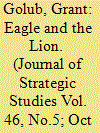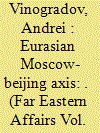| Srl | Item |
| 1 |
ID:
193173


|
|
|
|
|
| Summary/Abstract |
Many accounts of the formation of American and British grand strategy during World War II between the fall of France and the Pearl Harbor attacks stress the differences between the two sides’ strategic thinking. These accounts argue that while the Americans favored a ‘direct’ Germany-first approach to defeating the Axis powers, the British preferred the ‘indirect’ or ‘peripheral’ method. However, a review of Anglo-American strategic planning in this period shows that before official U.S. wartime entry, both sides largely agreed the British ‘peripheral’ approach was the wisest grand strategy for winning the war.
|
|
|
|
|
|
|
|
|
|
|
|
|
|
|
|
| 2 |
ID:
189293


|
|
|
|
|
| Summary/Abstract |
Russian-Chinese relations in the 20 years since the signing of the Grand Treaty of June 2001 have become a key factor of global development. Despite vigorous opposition from the West, their importance in world politics has steadily risen. They have encountered major challenges at all levels of cooperation (bilateral, regional, and global), but both countries have invariably responded to them effectively. Russia's role has grown steadily in proportion to the escalation of the China-US rivalry. Russia and China have shown that they complement each other not only on the level of bilateral economic relations, but also on a global scale, allowing them to address shared problems of creating a new international order and resisting pressure from the West. Extension of the Treaty has both confirmed the strategic nature of their relations and opened new areas of collaboration - ideological and otherwise. Amid growing tensions and the creation of new blocs in the Indo-Pacific region aimed at containing China, Russian-Chinese partnership is growing stronger without becoming a formal alliance. This type of harmonious and coordinated collaboration between major powers can be described as an axis.
|
|
|
|
|
|
|
|
|
|
|
|
|
|
|
|
| 3 |
ID:
184399


|
|
|
|
|
| Summary/Abstract |
The Russian factor in Sino-Iranian relations has been an outgrowth of Moscow's relations with Beijing and Tehran which each occupy distinct, though at times overlapping, roles in Russian foreign policy. Whereas the economic ties between Beijing and Tehran have been crucial in the evolution of Sino-Iranian relations, Russia-Iran relations have been driven by converging security concerns with an emphasis on regional issues ranging from the Caspian Sea to Afghanistan. This article begins with an overview of the convergences in Russia, China, and Iran's view of international order, which has materialised in the nascent collective efforts to contest the basis of ostensibly ‘liberal' norms and practices. It proceeds to examine the Russian and Chinese role in the evolution of the Iranian nuclear programme and joint Sino-Russian collaboration during P5+1 negotiations. Next, it shifts its focus to regional and domestic security through Iran's engagement with the Shanghai Cooperation Organisation (SCO) and through Beijing and Moscow's transmission of sovereignty-boosting practices to strengthen regime stability. Finally, it concludes with Iran's role in Russian efforts to link the Eurasian Economic Union (EAEU) and International North-South Transport Corridor (INSTC) with China’s Belt and Road Initiatives (BRI) as well as the wider efforts at supporting de-dollarisation. Yet, despite ideational convergences and coordination on salient issues, it would be erroneous to suggest the existence of a formidable Russia-China-Iran axis. Rather, the tripartite relationship between Russia, China, and Iran remains an illusory entente – bereft of regularised, institutionalised relations outside of their respective bilateral ties which tend to allow only modest trilateral coordination.
|
|
|
|
|
|
|
|
|
|
|
|
|
|
|
|
| 4 |
ID:
142934


|
|
|